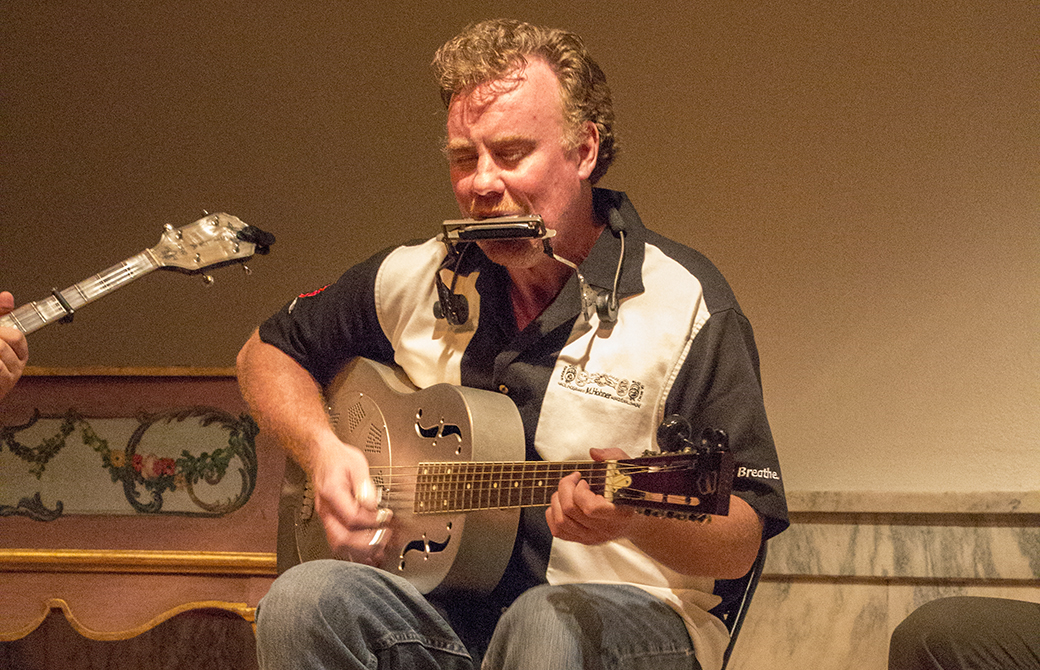
Harmonica man James Conway visits National Music Museum
James Conway, the harmonica man of Chicago, visited the National Music Museum on Friday night to demonstrate his harmonica skills. He brought his group, The Sprigs, along to help him showcase his varied harmonica styles.
Conway’s visit was organized by the museum’s director, Cleveland Johnson, to highlight the new harmonica exhibit on the second floor of the museum.
“These artists will lead you to be curious about what’s in this museum,” Johnson said. “The blessed, simple, innocent little harmonica.”
Conway was raised with a variety of musical influences. His musical gift was sparked at age six with the Celtic penny whistle and drum, and that Celtic influence is still a favorite of his and can be interpreted beautifully onto the harmonica.
“I’m known a lot for doing old time fiddle tunes and Celtic stuff,” Conway said. “There are some radically tuned ones that imitate bagpipes.”
At his showcase on Friday night, he demonstrated a few Celtic dance tunes which left everyone in the audience tapping their toes along to the jig.
Graduate student Rebekah McLaughlin was one listener who enjoyed the jig.
“I definitely want to jig and reel,” McLaughlin said. “That Celtic music is really fun. You can tell they’re into it too, they got their feet moving and bouncing.”
As he grew up, Conway’s taste soon changed from Celtic styles to more acoustic folk-rock heroes such as Neil Young and Bob Dylan. In fact, his favorite songs were Neil Young’s “I Am A Child” and “Heart of Gold.” He was drawn to the magic of guitar and harmonica played together.
“I’ve always been a big Neil Young fan and I’ve seen him many times,” Conway said. “I wanted to imitate these harmonica rack players. I thought that was virtuosic stuff back then before I started hearing what you could really do with it. That was pretty instrumental in my figuring out the harmonica.”
Growing up in Chicago led Conway to hang around in blues clubs. He said his favorite place he’s ever played in is a club called the Hideout in his home city, and that he was once a doorman at a similar blues club.
“I eventually became the door man just hanging out there and wanting to pick the brains of these few guys,” Conway said.
He had the chance to meet and learn from blues greats, the likes of Junior Wells, Sugar Blue, Howard Levy and more.
“I did actually sit down for a few paid lessons with the great Howard Levy after a couple decades of getting really into the advanced stuff,” Conway said. “Howard was considered one of the best diatonic players, and he lived pretty close to Chicago. I had countless micro-lessons from the great few players I mentioned.”
One song that Conway and his group played on Friday was an old folk tune called “Salty Dog Blues,” which was a tad bluesy and incorporated throat singing from Bill Knox on the banjo and some intense fiddling from Brendan Bulger on the fiddle.
Conway still takes part in the music scene in Chicago despite seeming to already know it all about the blues and the harmonica. He has a refined taste for all styles, he said.
“I like to go out to open mics still and just try out some new stuff,” Conway said. “I like to go out without any instruments too and just listen to new bands, blues or folk, rock and roll, sometimes even cover bands I go out and see.”
Conway also keeps a large collection of harmonicas. Even in a conversation, Conway will whip a few “mouth organs,” as he calls them, from his pocket and demonstrate their sound. He brought a suitcase of about 60 harmonicas up on stage with him for the night.
“I have many at home, a sickening amount,” Conway said.
Conway’s advice for starting musicians is to not be afraid of the harmonica.
“I really encourage people to take 20 to 30 bucks and get a decent harmonica,” Conway said. “Take advantage of its portability and take it with you and keep doing little micro-practices in the elevator and in the car. (Harmonicas) are a very unique instrument in the fact that it’s small and you get music from inhaling. You literally breath through this, you know? It’s a very special thing. It’s full of expression.”

